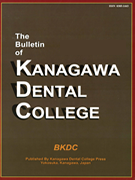- HOME
- > 一般の方
- > バックナンバー:The Bulletin of Kanagawa Dental College
- > 16巻2号
- > アブストラクト
アブストラクト(16巻2号:The Bulletin of Kanagawa Dental College)

English
| Title : | An Electron Microscopic Study of Multilamellar Structures in Osteoblasts in Vitro from Fetal Mouse Calvaria |
|---|---|
| Subtitle : | ORIGINAL ARTICLE |
| Authors : | Tsuneo Takahashi, Tsutomu Kono, Shinzo Makizumi, Kazuto Takahashi, Yoshihisa Watanabe*, Junichi Tatsumi**, Katsumi Ikeda**, Masayoshi Kumegawa*** |
| Authors(kana) : | |
| Organization : | Department of Oral Anatomy, Kanagawa Dental College, *Department of Oral Pathology, Kanagawa Dental College, **Department of Periodontology, Meikai University, ***Department of Oral Anatomy, Faculty of Dentistry, Meikai University |
| Journal : | The Bulletin of Kanagawa Dental College |
| Volume : | 16 |
| Number : | 2 |
| Page : | 81-88 |
| Year/Month : | 1988 / 9 |
| Article : | Original article |
| Publisher : | Kanagawa Odontological Society |
| Abstract : | [Abstract] Regarding the osteoblasts in the newly formed bone tissue obtained after a 10-day cultivation of mouse fetus parietal bone fragments, the ultrastructure was comparatively investigated by 1) a routine single glutaraldehyde fixation and by 2) a mixed glutaraldehyde-paraformaldehyde-tannic acid fixation, followed by osmium tetroxide containing potassium ferrocyanide/postfixation. The concentration of tannic acid utilized was low (0.2%), and the penetration of tannic acid into bone tissue and cells was satisfactory. The most distinct difference between the two methods lies in the fact that when the second procedure was used, the osmiophilic multilamellar structure (MLS) was more often observed in such a manner as MLS overlaps on the membrane constituent of the endoplasmic reticulum and the Golgi apparati in cells, and they were also observed on the cell membrane and in calcifying osteoid. These MLSs had a repeating unit structure (unit width ca. 7nm) composed of a regular bright and dark zones. This MLS had similar morphological characteristics with surfactant in alveolar type II cell. A possible physiological function of observed MLS in osteoblast was discussed. |
| Practice : | Dentistry |
| Keywords : |
